Tipos de copas de vino, y cuando utilizarlas
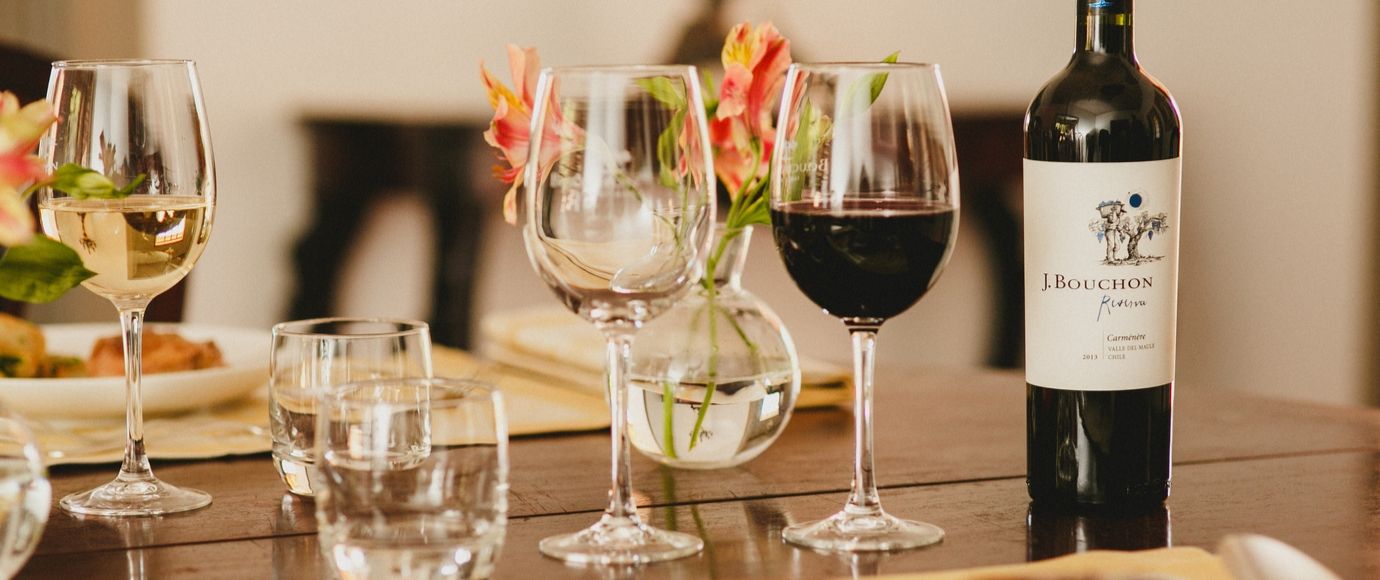
Disfrutar de un buen vino dependerá de varios factores, y uno de ellos sin duda es la copa que usemos. Aquí te explicaremos los tipos de copas de vino que te puedes encontrar y el vino ideal para cada una de ellas.
Copas de vino: Todo lo que debes saber
Gracias a las copas se pueden apreciar de mejor manera los sabores y olores del vino. Estos encierran entre 400 y 500 sustancias volátiles y aromáticas, por lo que la copa es muy importante, ya que ayuda a mantener estas sustancias, mostrando mejor el carácter del vino y sus aromas. Un mismo vino es totalmente distinto de acuerdo a la copa con la que lo degustes.
1 | Copas para vino tinto
Para beber vino tinto se suelen usar copas con el cáliz más ancho que la boca., y de esta manera apreciar mejor el bouquet. Las copas de vino tinto son más grande que las de vino blanco, lo que permite percibir mejor su aroma. Esto se debe en gran parte a que los sabores y olores más intensos requieren de un espacio mayor para que el vino tenga más contacto con el oxígeno.
Las copas más frecuentes que encontramos en esta categoría son:
–Borgoña, ideal para vinos tintos con cuerpo, elevada acidez y tanino moderado. Barbaresco, Barbera, Barolo, Burgundy (tinto), Gamay, Nebbiolo, Pinot Noir.
–Burdeo, para vinos tintos jóvenes, con cuerpo y complejos. Cabernet Sauvignon, Cabernet Franc, Merlot, Rioja y Tempranillo.
–Shiraz / Syrah: ideal para tintos amplios en boca, de estructura marcada y final prolongado. Amarone, Blaufrankisch, Chateauneuf-du-Pape, Grenache, Hermitage rouge, Malbec, Mourvedre, Pinotage, Shiraz, Syrah.
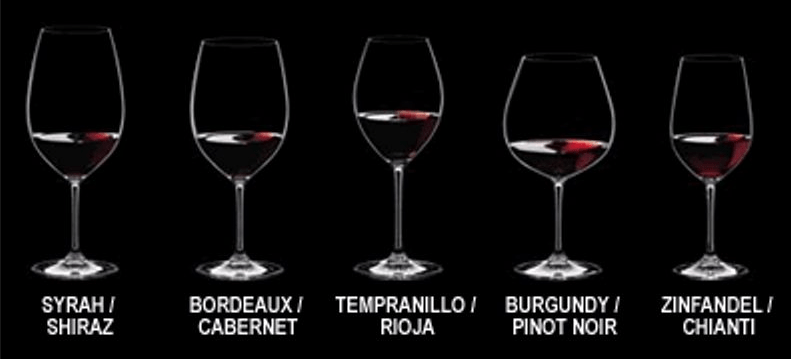
Foto: Riedel
2 | Copas de vino blanco
Las copas de vino blanco cuenta con el pie más largo, esto es para que el vino no se caliente por estar en contacto con la mano al sostenerlo. Y tienen el cáliz más pequeño, siendo un poco más alargadas y estrechas que las copas de vino tinto, de modo conservan el frío, ya que los vinos blancos suelen servirse fríos para apreciarlos mejor.
A pesar de estas características presentes en la mayoría de estas copas, existe una copa que rompe con los estándares establecidos, la copa Montrachet / Chardonnay, cuyo cáliz es muy amplio y con borde curvado hacia el interior para canalizar y potenciar su aroma.
Podemos encontrar distintos modelos de copas para vinos blancos, entre ellas hay:
–Sauvignon Blanc: ideal para vinos de la cepa lanc fume, Fume blanc, Rotgipfler, Sancerre, Sauvignon Blanc, Semillon, Spatrot-Rotgipfler, Zierfandle.
–Montrachet / Chardonnay: para blancos fermentados en barricas. Burgundy (white), Chardonnay (oaked), Corton-Charlemagne, Meursault, Montrachet, Morillon (oaked), Pouilly-Fuissé, Riesling (Spätlese / late harvest dry), Riesling Smaragd, Smaragd, St. Aubin.
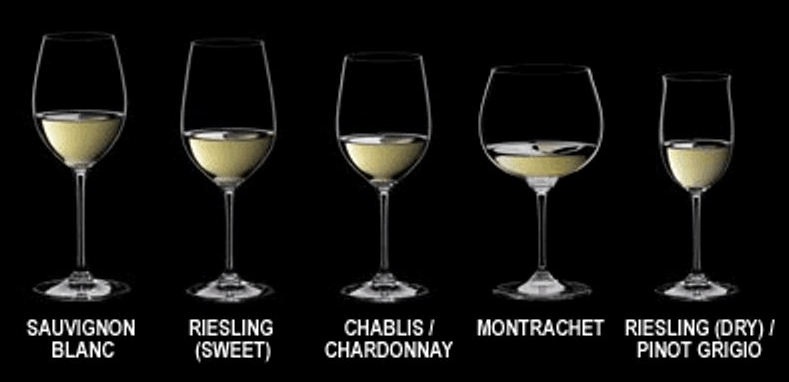
Foto: Riedel
3 | Copas de vino espumoso
Las copas para vinos espumantes son alargadas y afinadas. La estrechez contribuye a mantener la carbonatación de la bebida y apreciar mejor su sabor. El cuerpo largo de flauta va aumentando la anchura hacia la boca, facilitando la formación de burbujas en el tope.
Entre las copas de espumante se encuentran dos sub-tipos. Las primeras son las copas de boca ancha, conocidas como “copas planas o pompadour”, que se utilizan para servir cócteles de espumante. Las otras son las copas de boca estrecha, comúnmente llamadas “flautas”, las cuales son un poco más estilizadas y mantienen más adecuadamente las burbujas. Estas últimas copas se usan para degustar directamente un vino espumante. Si se trata de un gran espumante, la recomendación es usar también en copa de vino blanco.
La copa flauta es la más conocida y usada para este tipo de vino. Una de sus características es el largo del pie, el cual ayuda a sostener bien la copa sin afectar su temperatura. Además, su forma permite que se puedan apreciar de mejor manera las burbujas cuando van subiendo hacia arriba.
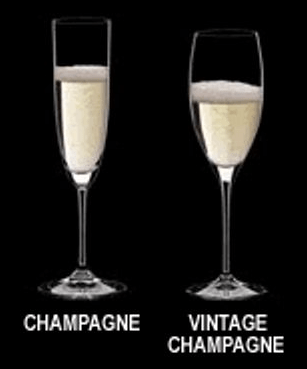
Foto: Riedel
4 | Copas de vino dulce
Estás copas deben ser más pequeñas, para así dirigir el vino a la parte posterior de la boca. También se debe tener presente que al igual que otros licores dulces, estos vinos contienen un mayor contenido alcohólico y estas copas pequeñas ayudan a regular las porciones ingeridas.
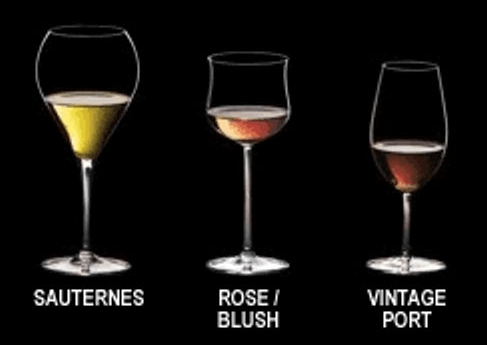
Foto: Riedel
Elementos a considerar en las copas de vino
Hay ciertos elementos que influyen en la calidad de las copas, entre ellos, el tamaño, la forma, el tallo, el diámetro del borde y el cristal.
- El tamaño de la copa influye en la calidad de percepción como la intensidad aromática que posee el líquido.
- La forma debe ser convexa o en forma de tulipán con borde inclinado hacia el interior para canalizar y potenciar los aromas. La forma variará de acuerdo al tipo de cepa que se quiera catar.
- El tallo debe ser largo para sostener la copa sin tocar el cáliz con la mano, ya que de esta forma se puede afectar la temperatura del vino.
- El diámetro del borde define la inclinación de la cabeza al momento de degusta. La postura de ingestión ayuda a saborear el vino en diferentes zonas de la lengua, activando los sectores sensoriales que se encuentran en ella.
- El cristal, cuyo grosor afecta la cata del vino. Una copa de cristal es fina e incolora ofreciendo una mejor visión del vino, además que permite acumular sus aromas por más tiempo.




